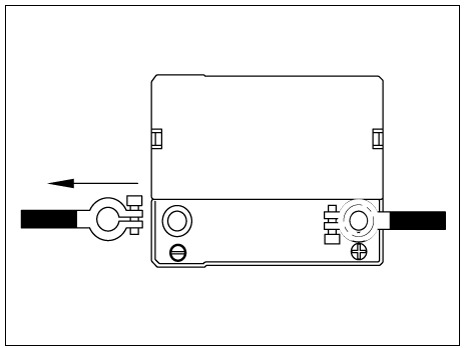KIA Niro: Cleaning
- Make sure the ignition switch and all accessories are in the OFF position.
- Remove the battery from the vehicle.
(Refer to Charging System - "Battery")
Warning
Care should be taken in the event the battery case is cracked or leaking, to protect your skin from the electrolyte.
Heavy rubber gloves (not the household type) should be worn when removing the battery.

- Inspect the battery tray for damage caused by the loss of electrolyte. If acid damage is present, it will be necessary to clean the area with a solution of clean warm water and baking soda. Scrub the area with a stiff brush and wipe off with a cloth moistened with baking soda and water.
- Clean the top of the battery with the same solution as described above.
- Inspect the battery case and cover for cracks. If cracks are present, the battery must be replaced.
- Clean the battery posts with a suitable battery post tool.
- Clean the inside surface of the terminal clamps with a suitable battery cleaning tool. Replace damaged or frayed cables and broken terminal clamps.
- Install the battery in the vehicle.
- Connect the cable terminals to the battery post, making sure tops of the terminals are flush with the tops of the posts.
- Tighten the terminal nuts securely.
- Coat all connections with light mineral grease after tightening.
Warning
When batteries are being charged, an explosive gas forms beneath the cover of each cell. Do not smoke near batteries being charged or which have recently been charged. Do not break live circuit at the terminals of batteries being charged.
A spark will occur when the circuit is broken. Keep open flames away from battery.
Battery Sensor Specification
Specifications

Description
Vehicles have many control units that use more electricity. These units
control their own system based
on information from diverse sensors. It is important to have a stable power
supply as there diverse
sensors giving a variety of information. Battery sensor (A) is mounted on
battery (-) terminal. It
transmits battery voltage, current, temperature information to ECM. ECM controls
generating voltage
by duty cycle based on these signals.

READ NEXT:
 Battery Sensor Repair procedures
Battery Sensor Repair procedures
Removal
Open the trunk.
Remove the luggage side trim (RH) side cover (A).
Turn the ignition switch OFF and disconnect the battery negative (-)
terminal (A).
Disconnect the battery sensor connector (B).
Battery (-) terminal tig
 Ignition System
Ignition System
Description
Ignition timing is controlled by the electronic control ignition timing
system. The standard reference
ignition timing data for the engine operating conditions are preprogrammed in
the memory of the ECM
(Engine Control Module).
 Ignition Coil Repair procedures | Spark Plug Repair procedures
Ignition Coil Repair procedures | Spark Plug Repair procedures
Removal
Turn ignition switch OFF and disconnect the battery negative (-) terminal.
Remove the engine cover.
Disconnect the ignition coil connector (A).
Remove the ignition coil (A) after loosening the mounting bolt.
I
SEE MORE:
 Blind-Spot Collision-Avoidance Assist malfunction and limitations
Blind-Spot Collision-Avoidance Assist malfunction and limitations
Blind-Spot Collision-Avoidance Assist
malfunction
A: Check blind-spot safety systems
When Blind-Spot Collision-Avoidance
Assist is not working properly, the warning
message will appear on the cluster
for several seconds, and the master (
 Replacing glove box lamp (Bulb type)
Replacing glove box lamp (Bulb type)
Operation
Using a flat-blade screwdriver, gently
pry the lamp assembly from interior.
Remove the cover from the lamp
assembly.
Remove the bulb by pulling it straight
out.
Install a new bulb in the socket.
Install the cover
Categories
- Home
- KIA Niro EV, Hybrid - Second generation - (SG2) (2021-2024) - Owner's manual
- Kia Niro - First generation - (DE) (2017-2022) - Service and Repair Manual
- Contact Us
